Reimagining the Art of the Possible
COVID has instigated a host of strategic and tactical changes in manufacturing which will be permanent features of the industrial landscape for years to come, rewriting leadership’s playbook and redefining the rules of competition.

The fallout of COVID-19 has affected many aspects of the manufacturing industry over the past year, but one of the most significant has been a heightened urgency about adopting Manufacturing 4.0 technologies and techniques to deal with what was and continues to be unprecedented business disruption.
Many manufacturing executives acknowledge that the equivalent of several years’ change has been compressed into the past year. Companies had to respond quickly to the pandemic crisis, adapting production environments, standing up new health and safety protocols, enabling more front-line workers to do their jobs remotely, and, in some cases, pivoting to produce products, such as life-saving ventilators and masks, that they had never produced before.
A key ally enabling such rapid change, many found out, was M4.0 digitization. Those that had already embraced the digital model had an easier time adapting; those that did not had greater difficulty.
For manufacturing leadership, the time has been both a test and an opportunity. Leaders have had to deal with the daily stress of keeping the business running, making sure employees were safe and engaged, and reacting to often unpredictable changes in demand. But they have also been able to arrive at a broader view of what’s possible. Now, executives across the industry are in the process of deciding what COVID-compelled changes may take root in their companies and which may not.
The Manufacturing Leadership Council’s new research survey on Next-Generation Leadership and the Changing Workforce, one of MLC’s Critical Issues facing the industry, sheds considerable light on what COVID-related changes are top of mind for leaders, how leaders are thinking about their role in the digital era, what knowledge and expertise will be needed in the future, and what key challenges they envision along the way.

New disaster preparedness, resiliency, and remote working strategies will become permanent features of manufacturing leadership’s playbook.
The Effects of COVID
MLC research over the past year has clearly documented that manufacturers want to accelerate their adoption and use of M4.0 as a direct result of the pandemic. The new Next-Generation Leadership survey reveals the implications of this tighter embrace.
A solid majority of the new survey’s respondents, 54.8%, confirm that COVID-19 has increased management’s focus on digital transformation (chart 1). New procedures for remote working by leadership teams and employees, new disaster preparedness and resiliency strategies, and more cross-functional organizational structures are among the most significant implications cited by survey respondents (chart 2).
But when asked whether these and other management strategies and tactics will end up being permanent elements in leadership’s playbook going forward or just temporary, a result extraordinary in the annals of MLC research occurred.
Powerful majorities said that most of the changes they were asked about will become permanent elements of their leadership approach. For example, 68.2% said that new disaster preparedness plans, resiliency strategies, and response teams will become permanent features in their companies. Likewise, 57.3% said that more collaborative, cross-functional organizational structures will take root. And 62.2% expect that remote working by both leadership teams and employees will continue (Chart 3).
Defining Leadership
As these changes take place, the definition of what operational leadership means in the digital era is becoming more deeply engraved in that metaphorical playbook.
In the new survey, 75% of respondents say that establishing a fact-based, information-driven culture of decision-making in their organizations is the statement which best describes what leadership means in the M4.0 era. This finding is up six points from 2020’s survey.
The two other statements which received the highest responses (survey takers were asked to rank their top three choices from a list of seven options) are: having the skills to orchestrate employees, customers, and business partners in a digitally driven, collaborative business ecosystem, at 55.5%, and understanding what it means to fully integrate digital technology in order to operate the business, at 54.1% (chart 4).
Notable, though, is the finding on aggressively adopting advanced IT and operational technologies. This year, the percentage of respondents citing this statement leapt 11 points to 29.1% of the sample compared to 2020, an increase which may reflect the desired acceleration of M4.0 as a result of the pandemic.

“Establishing a fact-based, information-driven culture of decision-making is once again the most popular definition of what leadership means in the M4.0 era.”
And when it comes to new skills that will be important for the digital era, survey respondents have reinforced the message about culture and collaboration by citing data analysis skills, understanding how to use digital technologies to advance manufacturing, and working in a collaborative environment as key areas of development (chart 5).
Perhaps as a result of the amount of change that has occurred in the past year, manufacturing executives are feeling somewhat better about how well prepared they and their teams are to manage the journey to M4.0.
The percentage of leaders who indicate they are not prepared for the journey has dropped nearly five points in this year’s survey, to 15.2% of the sample, while the percentage of those who have some degree of preparedness has rise slightly over last year (chart 7). For those who still feel that they are not prepared, the most cited reason, by 29.1%, is that they are simply not sure how M4.0 applies to their particular business (chart 8).
Nevertheless, perceptions about how vulnerable their company’s future success might be as a result of their level of M4.0 preparedness remain a mixed bag, with the percentage of those feeling very vulnerable rising to 15.2% of respondents this year, compared with eight percent in 2020, and those not feeling vulnerable at all dropping to 6.9%, from 12% last year (chart 9).
Desired Knowledge and Expertise
Looking ahead, what do manufacturing executives say are the most important leadership skills and abilities they feel they must develop to be successful with M4.0?
This year, once again survey respondents attach the highest degree of importance to the ability to rethink the business and successfully embrace the digital model. Even though the percentage of those indicating a high degree of importance to this ability dropped nearly six points from 2020, to 66.1% this year, this ability remains far ahead of other factors such as reducing costs and process integration. (chart 11).

“For manufacturing leadership, the past year has been an unprecedented test. But it has also been a time for more expansive thinking about what’s possible.”
And when it comes to a variety of technologies with which they feel they need to develop knowledge and expertise, this year’s survey findings strongly mirror last year’s results. For example, this year manufacturing executives once again attach a high level of emphasis to developing expertise around cybersecurity, advanced data analytics, and simulation and modeling (chart 12).
The quest for knowledge and expertise will play out against a backdrop of demographic and organizational challenges that will reverberate deeply in manufacturing companies.
The Challenges Ahead
As baby boomers retire, companies grapple with the persistent open job problem, and as they seek to understand what functions and skills they will need in an increasingly digital-influenced workforce, many manufacturers executives today see the primary source of next-generation leaders coming from their internal ranks.
But this year’s finding of 45.5% of respondents citing internal sources dropped nearly five points from last year’s survey, with a modest shift occurring in favor of finding talent elsewhere in the manufacturing industry. Fully one-third of respondents this year said they would be looking within the industry for talent. Only a fraction, 13.2%, expect to be sourcing candidates from other industries (chart 13).
These number could shift, of course, as manufacturers attain a greater understanding of what functions and skills they will need in the future. Today, only a fraction of survey takers, 7.4%, indicate they have a solid understanding of the new digital roles and skills they will need. About 65%, however, say these requirements are somewhat understood, up several points from last year, an encouraging sign. But where there is substantial headroom for improvement is in training. Only 22.3% of survey takers this year indicate they have formal training programs in place to educate workers and leadership about the requirements of M4.0 (charts 15,16).
As they work out these issues, leaders today will also be grappling with the structure within which people will work, a structure which has been slowly but inexorably changing over the years to a flatter, more collaborative model of working. In this year’s survey, nearly half of survey respondents, 48.5%, identified understanding how the company should be organized as a result of new technologies as a key challenge for leadership, a finding up a whopping 23 points from last year. No doubt this finding has been flavored by the pandemic experience as more people have had to work remotely, but the effects of M4.0 technologies in empowering more people with information and thereby changing decision-making processes may also be a mounting factor (chart 14).
The effects of M4.0 technologies will also have an impact on workforce size, as a significant number of manufacturers are looking at automation and advanced M4.0 technologies as ways to address the open jobs problem. This year, 41.7% of respondents said these technologies will help offset the difficulty in filling open jobs, up from 36% last year.
What the Future May Hold
As historians have pointed out, sometimes great crises give rise to new and better ways of doing things, enabling progress. The heightened sense of urgency in created digitally-powered agility as a result of the pandemic has fostered a broad set of strategic and tactical changes across manufacturing, all adding up to an opportunity to redraw the boundaries of what was thought possible.
Now, manufacturing leadership has the responsibility to see these changes through. If they are successful in doing so, they will take the industry to a new and better level, raising the bar for all and redefining the rules of competition. M
Part 1: COVID-19 Impact
1. A Majority Says COVID Has Increased Focus on M4.0
Q: What impact has COVID-19 had on your leadership team’s focus on digital / M4.0 transformation? (select one)

2. Remote Working, Resiliency Top List of COVID-Related Changes
Q: What impact has COVID-19 had on your leadership approaches to managing your manufacturing enterprise? (rank each category)
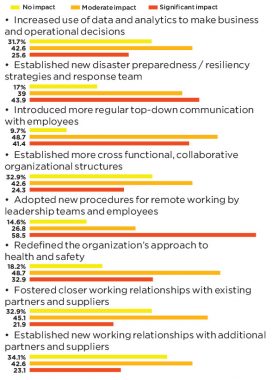
3. Solid Majorities Say Many Changes Will Be Permanent
Q: How long do you expect these new leadership approaches to continue? (rank each category)
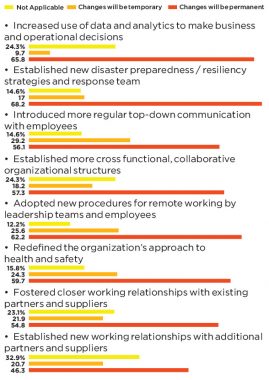
Part 2: Defining the Leadership Role
4. Once Again, Building a Fact-Based Culture is Top Leadership Definition
Q: Which statement best describes what leadership means in the Manufacturing 4.0 era? (Rank top 3)
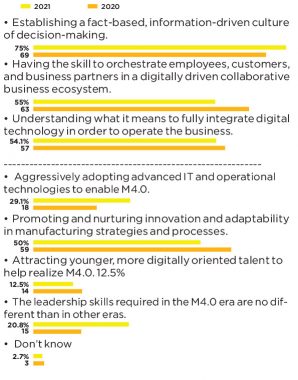
5. Data Orientation, Digital Acumen Lead Desired Skills
Q: Which new approaches and skills do you feel will be most important for the M4.0 era? (Rank top 3)
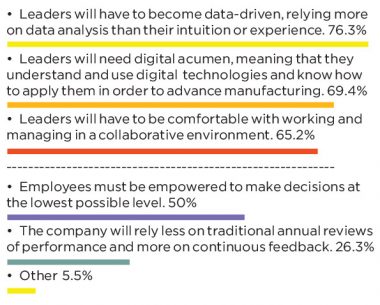
6. The M4.0 Business Case Remains Key Question
Q: What’s the most important thing your company’s executive management team wants to know about M4.0? (Select one)
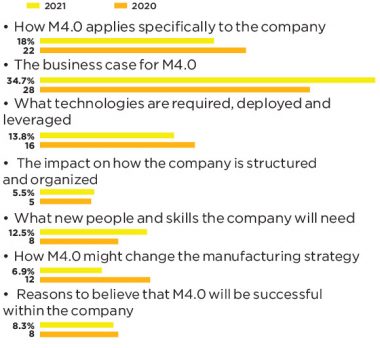
7. Slight Improvement in M4.0 Preparedness
Q:How prepared do you think your company’s executive management team is to lead and manage the journey to M4.0? (Select one)
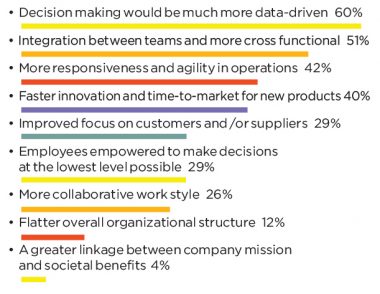
8. M4.0 Applicability is Key Issue in Preparedness
Q: If your company’s executive management is not well prepared for M4.0, what is the most important reason for the lack of preparedness? (Select one)
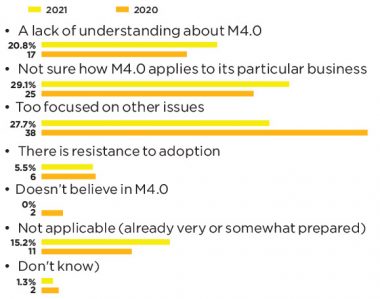
9. Perceptions of M4.0 Vulnerability Rise
Q: How vulnerable will your company’s future success be as a direct result of your company’s current level of M4.0 preparedness? (Select one)
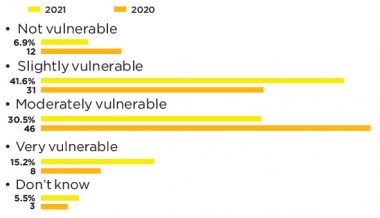
10. M4.0 is Largely a Collaborative Effort
Q: Who is leading the charge around your digital
transformation efforts in your organization? (Select one)
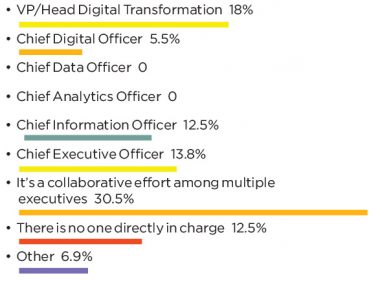
Part 3: Developing Knowledge and Expertise
11. Rethinking the Business is Key M4.0 Skill
Q: Looking ahead, what degree of importance would you assign to the following M4.0 leadership skills and abilities? (Rate each on scale of Low/Medium/High
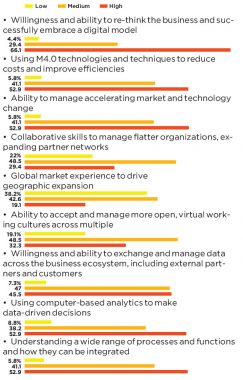
12. Cyber, Analytics Top List of Desired Knowledge
Q: Looking ahead, what degree of emphasis would you place on the following technology areas in terms of developing knowledge and expertise? (Rate each on scale of Low/Medium/High)
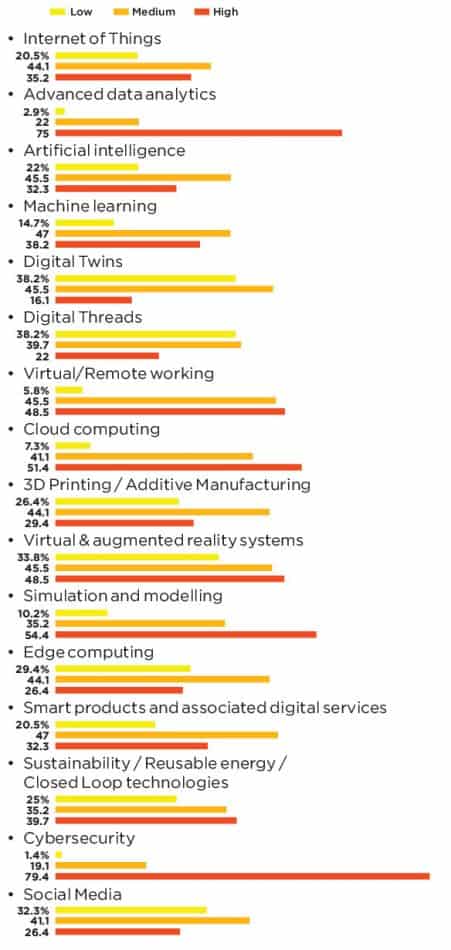
Part 4: Assessing Leadership Challenges
13. Most See Next Gen Leaders Sourced Internally
Q:Where do you see the next generation of leaders coming from for your company? (Select one)
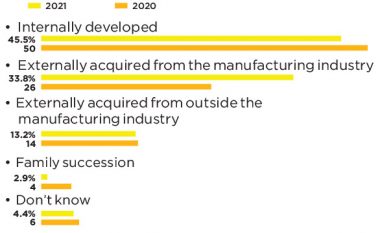
14. M4.0 Organizational Impact is Top Challenge
Q: In thinking about the requirements and implications of M4.0, what do you think are the most important challenges for leadership? (Rank top 3)
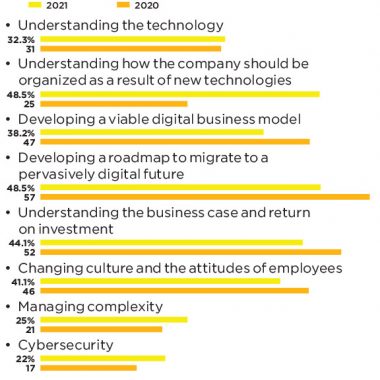
Part 4: Workforce Development and Transition
15. Understanding Digital Skills Makes Little Progress
Q: How well prepared do you think your company is in understanding the new digital roles and skills that you will need in the next few years? (Select one)
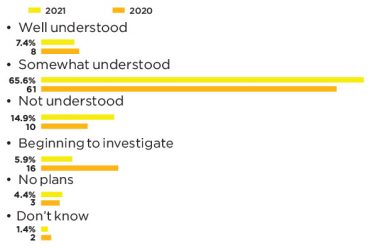
16. Vast Majority Still Without Formal M4.0 Training
Q: Does your company have a formal training plan to educate workers and leadership around the requirements of Manufacturing 4.0?
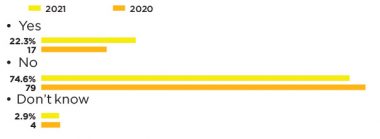
17. Automation Seen as an Open Jobs Remediator
Q: What impact do you think the increasing adoption of automation and advanced M4.0 technologies will have on workforce levels in your company in the future? (Select one)
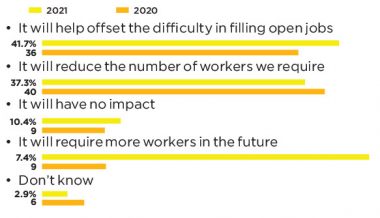
Survey development was led by David R. Brousell, with input from the MLC editorial team and the MLC’s Board of Governors.